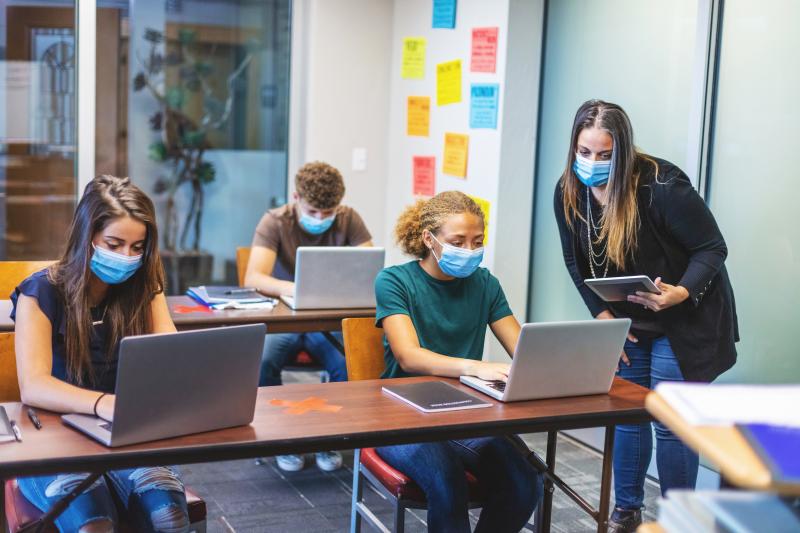Class of 2020 Postsecondary Enrollment Plummeted - What Now?
GettyImages-1257213326.jpg

Discouraging statistics emanating from the COVID-19 pandemic are so numerous in so many sectors that it can be difficult for any one of them to be attention-grabbing at this point. Still, try this one:
Postsecondary enrollments for the high school class of 2020 declined 22 percent compared to the class of 2019.
That estimate comes from a report released in December by the National Student Clearinghouse Research Center.
While high poverty high schools (where 75 percent or more of students are eligible for the free or reduced price lunch program) saw the steepest decline of 32.6 percent, high schools across the board all saw enrollment declines:
A report from the National Student Clearinghouse also notes, “The immediate college enrollment rate decreased to 27.7 percent from 35.3 percent last fall, a decline ten times steeper than last fall’s drop (from 35.9 percent in 2018 to 35.3 percent in 2019).”
Given observed declines in FAFSA completion, college applications, and fall enrollments, the news that last year’s seniors’ postsecondary outcomes plummeted is perhaps not that surprising.
But it is devastating for those students and their families, communities, states, and the United States, from the perspective of educational attainment, the economy, and the workforce. Fewer students pursuing postsecondary pathways will do little to close the skills gap long identified by the U.S. Chamber of Commerce Foundation, leaving employers scrambling to find workers with the competencies they need.
National College Attainment Network (NCAN) members observe that continuous enrollment from high school to postsecondary pathways has a much higher likelihood of eventual student success.
At this point, the best thing federal policymakers can do for the class of 2020 is to ensure that the rollout and distribution of the COVID-19 vaccines go smoothly. A return to normalcy will give practitioners and institutions the breathing room to reach these students and make a return to the classroom seem both plausible and worthwhile.
Postsecondary affordability can also be addressed in a meaningful way. Doubling the Pell Grant and restoring its purchasing power is an investment that can be made in individuals that will reverberate benefits through families, communities, states, and the country. This would send a clear message to students that they can afford a degree or certificate pathway.
However, we need more postsecondary on-ramps for the class of 2020 (and for the class of 2021 given where its FAFSA completion is at this point in the cycle). Those on-ramps like AmeriCorps can offer students the opportunity to gain valuable skills in the classroom and through work experiences. AmeriCorps offers students the ability to serve community-based organizations, colleges and universities, and public agencies through both direct service and capacity-building activities. After completing their service, Corps members can earn an education award equal to the maximum Pell Grant in their year of service. That award can finance a postsecondary pathway. There are about 75,000 AmeriCorps members annually, but there are more than that many students from the class of 2020 alone whose postsecondary pathways were disrupted.
State policymakers can also play a critical role in supporting students’ postsecondary transitions, including removing barriers to making those transitions, pivoting federal funds toward college and career supports, and using data to improve decision-making.
Earlier this year, U.S. Chamber of Commerce President Suzanne Clark proposed three potential solutions to closing the skills gap:
- Increase upskilling initiatives for current employees;
- Work with educational programs to strengthen talent pipelines; and
- Improve alignment between educational program curricula and the skills needed in the workforce.
Talent Pipeline Management (TPM) emerged to help align classrooms and careers at scale, and the TPM curriculum has appeared in 33 states and the District of Columbia.
State and local chambers of commerce also have a role to play. They can be strong partners working with K-12 districts and schools, higher education institutions, and community-based organizations to increase opportunities to college and high-quality career pathways for students.
The Detroit Regional Chamber and the Detroit College Access Network formed the Detroit Drives Degrees (“D3”) initiative. Given the summer melt phenomena where college-intending students fail to matriculate in the fall for any number of reasons, D3 aims to provide both high school students and adult learners with workshops on financial aid and college checklists along with text message reminders and personalized coaching that will help them get to and through a postsecondary pathway. The goal is to train the next generation of talent, retain and place it locally, and attract the next generation in a virtuous cycle. This strategy fits in well with NCAN recommendations on how to support students by making sure they are informed about their options, helping them accomplish intermediary steps to achieve them, and tracking progress systematically with data.
The D3 formula is one that would be valuable across the country. Chambers can be a catalyst in bringing education and nonprofit stakeholders to the table and laying out a vision for an education-to-workforce pipeline that does well by individuals and the community at-large. Chambers can help identify areas of regional or local workforce need, map competencies against existing K-12 and postsecondary curricula, develop new curricula as needed, and connect graduates with workforce placements.
For more on chamber-led education initiatives, consider the first half of this Lumina Foundation podcast, which features David Rattray of the Los Angeles Area Chamber of Commerce.
The critical role that chambers at all levels can play in connecting education and the workforce is hardly novel for readers of the Chamber Foundation’s blog, but the reminder is critical in light of the National Student Clearinghouse’s recently released data. A 22 percent decline in postsecondary enrollment represents a devastating impact on both students’ current circumstances and future opportunities. It will take a considerable effort by policymakers and practitioners working in concert to reconnect the class of 2020 with a postsecondary pathway and ensure that a similar fate does not befall the class of 2021.
_153df.png)